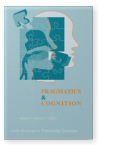Vol. 11:2 (2003) ► pp.327–344
The pragmatic marker like in English teen talk
Australian Aboriginal usage
This study reports on the use of like in Aboriginal English teen talk. The analysis of a sub-corpus of 40 adolescent texts from a corpus of 100 narratives by speakers of Aboriginal English in Western Australia revealed that like is often employed by these speakers, and that it achieves a multitude of functions. In general it is observed that like may mark off a) a discrepancy between the intended conceptualization and the expressed concept, b) an attitude, feeling, or certain degree of commitment towards a lexical item, and c) a shift in some element of discourse. The results of this study support and extend the analysis carried out by Andersen (2000) on London teen talk.
Cited by (10)
Cited by 10 other publications
This list is based on CrossRef data as of 10 july 2024. Please note that it may not be complete. Sources presented here have been supplied by the respective publishers. Any errors therein should be reported to them.
